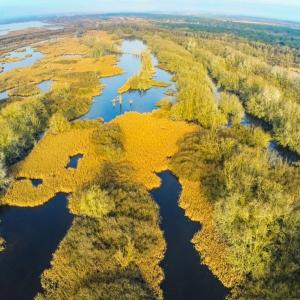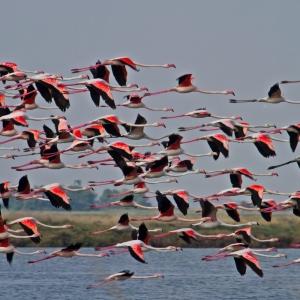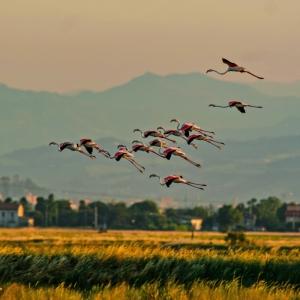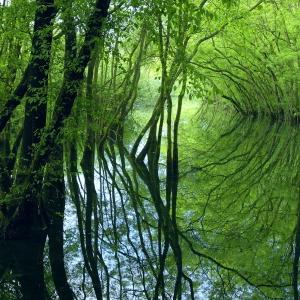THE PINEWOOD AND THE WHITE GOLD
For Ravenna and its inhabitants, the pine forests have a deep historical and cultural meaning and, although they no longer are as expansive as they once were, they still retain all their charm, standing out as the predominant element of the coastal landscape from the mouth of the Reno river to Cervia. Many of the environments within - active dunes, consolidated relict dunes now occupied by trees, dry arid meadows and
humid lowlands - are residual strips of an habitat that can no longer be found along the Adriatic coast.
The current pinewoods stretch across sand dunes that date back to the XIIth century, but the introduction of this pine happened much earlier; in the Augustan age, this native plant of the Mediterranean coast was used for the construction of ships of the Roman fleet in the ports of Ravenna, but mostly at Classe. In addition to these precious green woods, there are the Saline of Cervia, a protected wetland of great historical and environmental value. Today, these precious salt works, that produced their "white gold" that could be used in trade and were of vast strategic importance, boast many visitors, particularly because of their location at the Southern Gate of the Po Delta Park. The saltpans are still used to produce salt, but also are home to complex biological communities, including plant and animal species that live in habitats so extreme as to require special forms of adaptation.
RAVENNA: THE TREASURE OF BISANZIO
Ravenna, once a small Roman colony lying on the Adriatic coast and protected by a large marshy lagoon, became a important city in the year 402, when the Roman Emperor Honorius chose it as capital city of the empire. Not far away, one of the two imperial naval bases was established, the classis, from which Classe took its name. The city was enriched with magnifi cent palaces, but the crisis of the Empire left the way open for the Barbarian peoples who eventually settled here with Ravenna as their own capital. So it was that the Goths of the great Theodoric made Ravenna their kingdom (493-526). In this period fl ourished the famous palaces and places of worship of Aryan Christianity. After the next Gothic War, new buildings transformed the face of the city into a great Byzantine treasure. In 751, the city fi nally fell into the hands of the Lombards. Then the moment of imperial importance passed, and for centuries the city was a small feudal manor and later became a colony of Venice. This occupation marked the birth of a new urban fabric, creating the city as we know it today. Soon, it would be a province of the Papal States (the Romagne) until the unification of Italy.
Now Ravenna proudly exhibits the treasures of its past, included in the list of UNESCO World Heritage Sites. If its history made it famous in the world, its beaches and pine forests give it additional beauty and, every year, it attracts many tourists, thanks also to modern amenities and theme parks. It offers a holiday that combines culture, health, relaxation, good food and entertainment.
THE PINEWOOD OF RAVENNA:
WHERE WATER AND EARTH MEET
The Pinewood of San Vitale is made of clearings, usually dry, in the middle of a forest of pines, ashes, white poplars and oaks, many of which vegetate with the base of the trunk immersed in water. The presence of Pine, black Poplar and Willow is due to reforestation activities, which took place in ancient and modern times. The undergrowth is full of Hawthorn, Blackthorn, Dogwood, Osyris, butcher's Broom, Asparagus and mushrooms. In this natural mosaic, pine forests alternate with marshy lowlands and freshwater wetland called pialasse, large brackish lagoons in contact with the sea through canals, with shallow water and silty-clay bottoms. The pialasse began to form in the Renaissance and owe their characteristics and their structure in large part to human activity; they bear a nearly complete sample of sublittoral sequences in different gradients of humidity and salinity. The southern portion of the site, is considered a Wetland of International Importance according to the Ramsar Convention.
The large lagoon is the main source of food for the colonial breeding species of Punte Alberete and Valle Mandriole, like the Egret, Squacco Heron, Great Egret, Spoonbill, Glossy ibis, Pygmy Cormorant, Cormorant and Whiskered Tern, as well as for a rich variety of migratory avifauna.
ORTAZZO, ORTAZZINO AND THE MOUTH OF BEVANO
This site boasts some of the greatest biodiversity on the coast of Emilia Romagna. It covers the mouth of the Bevano river, last meandering estuary of the northern Adriatic free to evolve naturally; fi ve kilometers of active coastal dunes; the coastal pinewood with Pinus pinaster behind it, and the system of brackish wetlands of Ortazzino and Ortazzo. The site also includes the 300 meter wide coastal strip. The mouth of the Bevano occupies an area of about 40 hectares and testifies, with its balance between water and sand, between tides and river fl ows, the morphology of the
coastal strip before human interference. The western part of the mouth, called Ortazzino, includes the fossil intricacies of Bevano, with part of the coastal dunes, the brackish wet meadows with groundwater outcrops behind, and dry meadows dominated by Common Juniper and Sea Buckthorn.
In this complex of wetlands and arid dunes are present virtually all types of halophytic flora of northern Adriatic, like annual and perennial glassworts, beachgrasses, rushes of the sea and puccinellie. Behind the dunes are the state pine forests, sections Ramazzotti and Savio, created at the end of the XIXth century on the coastal strip of more recent formation, with the aim to protect crops in the back, from the sea winds. The artificial pine forests have been added to the original shrubby vegetation typical of consolidated dunes which remains, in part, in the marginal bands and in the undergrowth.
PUNTE ALBERETE AND VALLE MANDRIOLE:
THE WONDERS OF THE SWAMP
Punte Alberete and Valle Mandriole represent the most recent examples of freshwater estuaries, the remains of swampy forests of the southern Padana valley. They originated from the complex hydraulic history of the Lamone river, which until the XIVth century did not have a well-defined flow and access to the sea. In fact, its waters were scattered in a vast expanse of lagoons. In 1839, the Papal Government organized the construction of a large fl ood plain, destined to collect water from the river and material transported during fl oods, thus preventing damage to the surrounding cultivated plain and encouraging, at the same time, the reclamation of marshland. The complex of the lagoons on the north side of the river is called Valle Mandriole (or della Canna) and is a freshwater lagoon characterized by alternating wetland and knolls covered with thick reeds. To the south of the oasis, there is a lookout tower from which you can see the many water birds that nest or stop here. The area located south of the Lamone River is called Punte Alberete. The oasis is a flooded forest with some beautiful scenery with hygrophilus woods that are partially flooded, flooded prairies that are open shallow water basins and typical flora and fauna of marshy areas of varying water depth. Protected flora and rare nesting birds are primarily located in the "heronry" and reeds. A product of the ancient reclaimed land of the Lamone river, this biotope is an example of "managed" natural evolution.
THE LAND OF SALT
Since prehistoric times, the low clay coasts of the Northern Adriatic, which are subject to high tide, were characterized by salt works. The water of the sea, exposed to the scorching sun, deposited salts. The salt works, Salina di Cervia, is an ancient structure, of probable Etruscan origin, evidence of the interaction between humans and the forces of nature. Southern gateway and station of Po Delta Park, the salt works extend to the coast in an area of 827 hectares, creating a complex of canals, ponds, small sluice gates and basins for the production of salt. Surrounded by a perimeter channel more than 14 kilometers long, it is connected to the sea by a canal tributary and emissary. Since 1959, the system of industrial processing has replaced the previous handicraft multiple collecting system. The 150 small salt works functioning at that time were replaced by a dozen large basins. Over time, some recognized that the salt works could offer new riches to everyone: its environmental treasures.
It is considered an environment of great natural and scenic interest, and now it's part of the Ramsar Convention as a Wetland of International Importance. Since 1979, it's been a State Natural Reserve of animal populations. In terms of birdlife, the salt works are populated by species such as the Flamingo, Black-winged Stilt, Avocet, and herons typical of the Po Delta. It is a resting and nesting area for several species of birds occupying the small banks and islands which are inside the basins.






